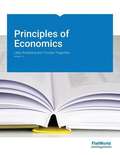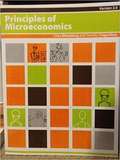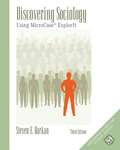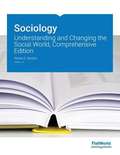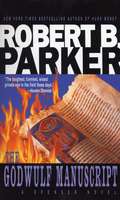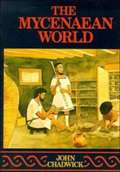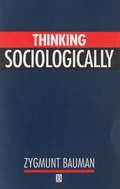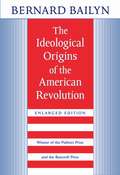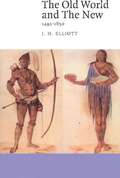- Table View
- List View
Money and Banking v 2.0
by Robert E. WrightThe financial crisis of 2007-8 has already revolutionized institutions, markets, and regulation. Wright's Money and Banking V 2.0 captures those revolutionary changes and packages them in a way that engages undergraduates enrolled in Money and Banking and Financial Institutions and Markets courses. Minimal mathematics, accessible language, and a student-oriented tone ease readers into complex subjects like money, interest rates, banking, asymmetric information, financial crises and regulation, monetary policy, monetary theory, and other standard topics. Numerous short cases, called "Stop and Think" boxes, promote internalization over memorization. Exercise drills ensure basic skills competency where appropriate. Short, snappy sections that begin with a framing question enhance readability and encourage assignment completion. The 2.0 version of this text boasts substantive revisions (additions, deletions, rearrangements) of almost every chapter based on the suggestions of many Money and Banking instructors. Some specific highlights are: Chapter 11 now contains enhanced descriptions of recent regulatory changes, including Dodd-Frank, Chapter 12 is an entirely new chapter on derivatives covering forwards, futures, options, and swaps that also including comprehensive treatment of the causes and consequences of financial crises, and Chapter 14 has updated discussions of the Federal Reserve's monetary policy tools, including paying interest on reserves, and the structure and leadership of the European Central Bank. Recent financial turmoil has increased student interest in the financial system but simultaneously threatens to create false impressions and negative attitudes. This up-to-date text by a dynamic, young author encourages students to critique the financial system without rejecting its many positive attributes. Peruse the book online now to see for yourself if this book fits the needs of your course and students.
Organizational Behavior v 1.1
by Talya Bauer Berrin ErdoganTwo leading researchers in Management, Talya Bauer and Berrin Erdogan, bring you a new Organizational Behavior textbook that bridges the gap between theory and practice with a distinct "experiential" approach. On average, a worker in the USA will change jobs 10 times in 20 years. In order to succeed in this type of career situation, individuals need to be armed with the tools necessary to be life-long learners. To that end, this book is not be about giving students all the answers to every situation they may encounter when they start their first job or as they continue up the career ladder.
Personal Finance
by Rachel Siegel Carol YachtPersonal Finance by Rachel Siegel and Carol Yacht is a comprehensive Personal Finance text which includes a wide range of pedagogical aids to keep students engaged and instructors on track. If you would like to hear Rachel talk about her book, and the Personal Finance course listen here to her podcast. This book is arranged by learning objectives. The headings, summaries, reviews, and problems all link together via the learning objectives. This helps instructors to teach what they want, and to assign the problems that correspond to the learning objectives covered in class. Personal Finance includes personal finance planning problems with links to solutions, and personal application exercises, with links to their associated worksheet(s) or spreadsheet(s). In addition, the text boasts a large number of links to videos, podcasts, experts' tips or blogs, and magazine articles to illustrate the practical applications for concepts covered in the text. Finally, the modular nature of the chapters lends itself to the Flat World Knowledge publishing model allowing instructors to adapt the textbook to the exact needs of their specific class and student body.
The Power of Selling
by Kim RichmondThe Power of Selling is the perfect textbook to teach students about the proven process of selling. More important, it teaches students how to apply the tenets of selling to how to sell themselves and get the job they want, with the same process professional sales people learn (or brush up) on their own selling skills. What makes someone successful in sales? Are great sales people born or made? Is there one magic selling process, or does the process change based on the business...or the customer? How can the selling process really come alive for students in the classroom? How do students learn how to sell for life, not just for a course? The Power of Selling by Kim Richmond answers these questions and makes the principles of selling come alive. Kim looks at the topic of selling through a different lens, and provides inspiration and ideas. The Power of Selling provides an exciting and interactive experience for both professors and students through the use of 4 unique elements: 1. Content The content is based on the core selling tenets so instructors will find the familiar principles of selling. In addition, the impact of Sales 2.0 is addressed at every stage including how to use interactive tools such as Twitter, LinkedIn, Facebook, blogs, and wikis effectively. 2. Selling U The last section of each chapter is called Selling U. It applies the concepts covered in the chapter to a student's job search. Selling U topics include how to think about yourself as a brand, how to create a powerful cover letter and resume, how to create your personal elevator pitch, how to use networking and informational interviews to get the word out about your brand, how to prepare and dress for an interview, and how to negotiate and accept the right job offer. What makes The Power of Selling different is that Selling U is integrated into every chapter, which makes this text the ultimate guide to selling yourself. 3. Video Resources Videos are used throughout the book. Additional videos that are not included in the text are available for instructor use. Here are videos that are available: * Video Ride-alongs - One of the best ways to learn about sales is by going on ride-alongs. So every chapter starts with an exclusive feature called a Video Ride-along. These short videos feature seven different sales professionals - one that starts each chapter. Each one talks about how he or she applies one of the key concepts covered in the chapter in their job. These videos are designed to be "virtual ride-alongs" so the students can actually feel as though they are getting insights first hand from selling professionals. * The Power of Selling YouTube Channel here (youtube.com/thepowerofselling) - Over 50 videos are included featuring the sales professionals who are highlighted in the Video Ride-alongs. About half of the videos are used in the textbook. The balance are available for instructor use. Several are included in Video Learning Segments (see below). These videos are excellent resources for use in the classroom, exercises, and assignments. * Video Learning Segments In addition to the traditional supplements of Instructor Manual, PowerPoints, and Test Bank, there are also Video Learning Segments. These are PowerPoint slides embedded with videos designed to supplement the course PowerPoints and focus on one concept, like an ethical dilemma, pre-call preparation, or effective presentations, how to use email effectively. Each segment includes slides, videos, discussion questions, or exercises. 4. The Power of Selling LinkedIn Group. here This group was created on LinkedIn.com expressly as a resource for the faculty and students who use this textbook. The group includes sales professionals from across the country and from different industries. This is a great tool for faculty and students alike to network, participate in discussions, ask questions, and connect with "real world" selling professionals.
Principles of Economics v 1.1
by Libby Rittenberg Timothy TregarthenVersion 1.1 boasts improved coverage throughout the text including significant updates to: Chapters 20 (GDP, Price Level Changes, Business Cycles, and Unemployment) Chapter 21 (Measuring Total Output and Income) Chapter 27 (Government and Fiscal Policy) Chapter 32 (Macroeconomics for the 21st Century).
Principles of Economics Version 2.0
by Libby Rittenberg Timothy TregarthenIn the macro chapters of Version 2.0 of Principles of Economics thoroughly incorporates the recent recession and recovery-- placing it in historical and theoretical context and not shying away from the controversies surrounding how government responded to it. In the micro chapters, all the time-sensitive data has been updated, along with over half of all the "Start Ups" and "Case and Point" applications being brand new or updated. Flat World Knowledge is thrilled to publish a re-launch of Tim Tregarthen's acclaimed Principles of Economics V. 2.0 book, and proud to bring Tim's remarkable talents as a teacher to future generations of students.
Principles of Macroeconomics
by Libby Rittenberg Timothy TregarthenFlat World Knowledge is honored to publish a new, first edition re-launch of Tim Tregarthen's wonderful principles of macroeconomics book, and proud to bring Tim's incredible talents as a teacher back to life so future generations of students can continue to learn from him. In 1996, he published the first edition of his principles of microeconomics textbook to great acclaim, and it became widely used in colleges around the country. That same year, MS made him wheelchair-bound. The disease forced his retirement from teaching at the University of Colorado at Colorado Springs in 1998. He lost the use of his arms in 2001 and has been quadriplegic ever since. Tim never let his disease get him down. In fact, he turned back to his love of writing and teaching for inspiration. He obtained a voice-activated computer, recruited a co-author, Libby Rittenberg of Colorado College, and turned his attention to revising his principles of economics book. Today we are excited to introduce Libby Rittenberg and Timothy Tregarthen's Principles of Macroeconomics. The authors teach economics as the study of "choice " by providing students with an accessible, straightforward overview of economics. This text combines the clarity and writing of Tregarthen's seminal periodical "The Margin" with great teaching insights. Rittenberg and Tregarthen help students to understand how real individuals actually work with economics. In this new book, the authors illustrate the practicality and relevance of economics with a variety of new illustrations and insights. The authors take a three-pronged approach to every concept: (1) the concept is covered with a "Heads Up" to ward off confusion, (2) a "You Try It" section makes sure students are staying on top of the concept and (3) a "Case and Point" section that uses a real-world application to harness the concept in reality. For one example of how this plays out in the text see "Chapter 3, Section 2 on Supply".here This book is intended for a one-semester course in Macroeconomics taught out the social sciences or business school.
Principles of Management
by Mason Carpenter Talya Bauer Berrin ErdoganPrinciples of Management by Carpenter, Bauer and Erdogan teaches management principles to tomorrow's business leaders by weaving three threads through every chapter: strategy, entrepreneurship and active leadership. Strategic: All business school teachings have some orientation toward performance and strategy and are concerned with making choices that lead to high performance. Principles of Management will frame performance using the notion of the triple bottom-line the idea that economic performance allows individuals and organizations to perform positively in social and environmental ways as well. The triple bottom line is financial, social, and environmental performance. It is important for all students to understand the interdependence of these three facets of organizational performance. The Entrepreneurial Manager: While the General Management course at Harvard Business School was historically one of its most popular and impactful courses (pioneered in the 1960s by Joe Bower), recent Harvard MBAs did not see themselves as general managers. This course was relabeled 'The Entrepreneurial Manager' in 2006, and has regained its title as one of the most popular courses. This reflects and underlying and growing trend that students, including the undergraduates this book targets, can see themselves as entrepreneurs and active change agents, but not just as managers. By starting fresh with an entrepreneurial/change management orientation, this text provides an exciting perspective on the art of management that students can relate to. At the same time, this perspective is as relevant to existing for-profit organizations (in the form intrapreneurship) as it is to not-for-profits and new entrepreneurial ventures. Active Leadership: Starting with the opening chapter, Principles of Management show students how leaders and leadership are essential to personal and organizational effectiveness and effective organizational change. Students are increasingly active as leaders at an early age, and are sometimes painfully aware of the leadership failings they see in public and private organizations. It is the leader and leadership that combine the principles of management (the artist's palette, tools, and techniques) to create the art of management. Cases: Mason provides brief cases in his Instructors Manual for those who take a case approach to the course or who wish to incorporate cases. This book's modular format easily maps to a POLC course organization (Planning, Organizing, Leading, and Controlling, attributed to Henri Fayol (1949, General and industrial management. London. Pitman Publishing company), and suits the needs of most undergraduate or graduate course in Principles of Management.
Principles of Marketing 2.0
by Mary Anne Raymond Jeff TannerPrinciples of Marketing Version 2.0 by Tanner, Raymond and Schuster teaches the experience and process of actually doing marketing - not just the vocabulary. It carries five dominant themes throughout in order to expose students to marketing in today's environment: Service dominant logic - This textbook employs the term "offering" instead of the more traditional First "P" -- product. That is because consumers don't sacrifice value when alternating between a product and a service. They are evaluating the entire experience, whether they interact with a product, a service, or a combination. So the fundamental focus is providing value throughout the value chain, whether that value chain encompasses a product, service, or both. Sustainability; Increasingly, companies are interested in the impact they are having on their local community as well as the overall environment. This is often referred to as the triple bottom line of financial, social, and environment performance. Ethics and social responsibility; Following on the sustainability notion is the broader importance of ethics and social responsibility in creating successful organizations. The authors make consistent references to ethical situations throughout chapter coverage, and end of chapter material in most chapters will encompass ethical situations. Global coverage -- Tanner, Raymond and Schuster deliberately entitled Chapter 1; What is Marketing?; Whether it is today's price of gasoline, the current U.S. presidential race, or Midwestern U.S. farming, almost every industry and company needs strong global awareness. And today's marketing professionals must understand the world in which they and their companies operate. Metrics -- Firms today have the potential to gather more information than ever before about their current and potential customers. That information gathering can be costly, but it can also be very revealing. With the potential to capture so much more detail about micro transactions, firms should now be more able to answer ;well, what this marketing strategy really worth it?; And what is the marketing ROI?; And finally, what is this customer or set of customers worth to us over their lifetime? Principles of Marketing Version 2.0 brings new and updated coverage of new developments in the influence of social media to empower consumers, as well as marketing's use of social media, such as sentiment analysis, mobile marketing, and customer service and complaint tracking, as a communications and promotion channel, just a name a few. Version 2.0 also has an overall increased number of examples, as well as, new discussion questions in every chapter (resulting in at least 10 per chapter). In addition, the textbook's key terms, and repeated concepts have been strategically arranged to make customizing this book with Flat World's MIYO platform even easier.
Principles of Microeconomics 2.0
by Libby Rittenberg Timothy TregarthenFlat World Knowledge is honored to publish Version 2.0 (an orginal re-launch) of Tim Tregarthen's wonderful principles of microeconomics book, and proud to bring Tim's incredible talents as a teacher back to life so future generations of students can continue to learn from him.
Risk Management for Enterprises and Individuals
by Etti Baranoff Patrick Lee Brockett Yehuda KahaneThis book is intended for the Risk Management and Insurance course where Risk Management is emphasized. When we think of large risks, we often think in terms of natural hazards such as hurricanes, earthquakes or tornados. Perhaps man-made disasters come to mind such as the terrorist attacks in the U.S. on September 11, 2001. Typically we have overlooked financial crises, such as the credit crisis of 2008. However, these types of man-made disasters have the potential to devastate the global marketplace. Losses in multiple trillions of dollars and in much human suffering and insecurity are already being totaled, and the global financial markets are collapsing as never before seen. We can attribute the 2008 collapse to financially risky behavior of a magnitude never before experienced. The 2008 U.S. credit markets were a financial house of cards. A basic lack of risk management (and regulators' inattention or inability to control these overt failures) lay at the heart of the global credit crisis. This crisis started with lack of improperly underwritten mortgages and excessive debt. Companies depend on loans and lines of credit to conduct their routine business. If such credit lines dry up, production slows down and brings the global economy to the brink of deep recession or even depression. The snowballing effect of this failure to manage the risk associated with providing mortgage loans to unqualified home buyers have been profound, indeed. When the mortgages failed because of greater risk- taking on the Street, the entire house of cards collapsed. Probably no other risk-related event has had, and will continue to have, as profound an impact world wide as this risk management failure. How was risk in this situation so badly managed? What could firms and individuals have done to protect themselves? How can government measure such risks (beforehand) to regulate and control them? These and other questions come to mind when we contemplate the consequences of this risk management fiasco. Standard risk management practice would have identified sub-prime mortgages and their bundling into mortgage-backed-securities as high risk. People would have avoided these investments or would have put enough money into reserve to be able to withstand defaults. This did not happen. Accordingly, this book may represent one of the most critical topics of study that the student of the 21st century could ever undertake. Risk management will be a major focal point of business and societal decision making in the 21st century. A separate focused field of study, it draws on core knowledge bases from law, engineering, finance, economics, medicine, psychology, accounting, mathematics, statistics and other fields to create a holistic decision-making framework that is sustainable and value- enhancing. This is the subject of this book.
Sexuality and Our Diversity: Integrating Culture with the Biopsychosocial Version 1.0
by Marcus TyeSexuality and Our Diversity: Integrating Culture with the Biopsychosocial by Marcus Tye explores, with an integrated approach, the complex dimensions of biology, culture, psychology, sociology, history, and philosophy that explain human sexual diversity. While this text is primarily focused on the present, it also explores selected aspects of history to lend perspective to students that contemporary controversies have deep historical roots.
Sociology
by Steven E. BarkanThis best selling software-based workbook lets students explore dozens of sociological topics and issues, using data from the United States and around the world. With the workbook and accompanying ExplorIt software and data sets, students won't just read about what other sociologists have done, they will discover sociology for themselves. DISCOVERING SOCIOLOGY will add an exciting dimension to the introductory sociology course.
Sociology: Understanding and Changing the Social World
by Steven E. BarkanThe founders of sociology in the United States wanted to make a difference. A central aim of the sociologists of the Chicago school was to use sociological knowledge to achieve social reform. A related aim of sociologists like Jane Addams, W.E.B. DuBois, and Ida B. Wells-Barnett and others since was to use sociological knowledge to understand and alleviate gender, racial, and class inequality. It is no accident that many sociology instructors and students are first drawn to sociology because they want to learn a body of knowledge that could help them make a difference in the world at large. Steve Barkan's Sociology: Understanding and Changing the Social World is designed for this audience. It presents a sociological understanding of society but also a sociological perspective on how to change society, while maintaining the structure and contents of the best mainstream texts.
Survey of Economics Version 1.0
by Libby Rittenberg Timothy TregarthenThis Survey of Economics textbook is intended for the one-semester introductory economics course. Building on the pedagogy developed in their successful two-semester Principles of Economics textbook, Libby and Tregarthen cover topics that will give students the tools to understand the economics way of thinking.
Sustainability, Innovation, and Entrepreneurship
by Andrea LarsonThis book is suited for the Entrepreneurship or Innovation course with an emphasis on Sustainability or for a course devoted entirely to Sustainability. The deep roots of sustainability thinking are now evident in widespread and increasingly visible activities worldwide, this text will help you and your students explore that necessity, its implications and its progression.
Mathematical Methods of Physics (2nd edition) (PDF)
by Robert Lee Walker Jon MathewsThis well-known text treats a variety of essential topics, ranging in difficulty from simple differential equations to group theory. Physical intuition, rather than rigor, is used to develop mathematical facility, and the authors have kept the text at a level consistent with the needs and abilities of upper-division students. This book covers subjects which are often ignored in traditional texts; for example, statistics and the fitting of experimental data, dispersion relations and super-convergence relations and the group SU(3).
Spenser Novel: The Godwulf Manuscript (PDF)
by Robert Brown ParkerSpenser earned his degree in the school of hard knocks, so he is ready when a Boston university hires him to recover a rare, stolen manuscript. He is hardly surpised that his only clue is a radical student with four bullets in his chest. The cops are ready to throw the book at the pretty blond coed whose prints are all over the murder weapon but Spenser knows there are no easy answers. He tackles some very heavy homework and knows that if he doesn't finish his assignment soon, he could end up marked D - for dead.
The Mycenaean World (PDF)
by John ChadwickJohn Chadwick summarizes the results of research into Mycenaean Greece and in so doing opens the door to a new world, Mycenaean Greece seen through the eyes of its inhabitants.
Why the Crimean War?: A Cautionary Tale
by Norman RichFrom an Amazon review: It was the first book that I read and felt like I truly understood how things worked in foreign policy. There are people and they have an agenda. Sometimes that agenda can create a firestorm that leads to catastrophe upon catastrophe. Rich tells the story of how, or rather why, the Crimean War began and the countless times it could have been averted. That war began, much like another may soon, when countries squabbled about who would have the honor to protect a minority in a country that did not endanger that minority.
Why the Crimean War?: A Cautionary Tale (PDF)
by Norman RichFrom an Amazon review: It was the first book that I read and felt like I truly understood how things worked in foreign policy. There are people and they have an agenda. Sometimes that agenda can create a firestorm that leads to catastrophe upon catastrophe. Rich tells the story of how, or rather why, the Crimean War began and the countless times it could have been averted. That war began, much like another may soon, when countries squabbled about who would have the honor to protect a minority in a country that did not endanger that minority.
Thinking Sociologically (PDF)
by Zygmunt BaumanIn this textbook, Bauman addresses the problem of thinking sociologically. Through an examination of the underlying assumptions and tacit expectations which structure people's view of the world, Bausman aims to elucidate key concepts in sociology, from individualism and community to privilege and deprivation. The author also offers the reader a succession of exemplary instances of thinking sociologically.
The Chaos Frontier: Creative Strategic Control for Business (PDF)
by Ralph D StaceyThe purpose of this book is to introduce senior business executives to a new scientific way of explaining the creative behaviour of dynamic systems, one of which is the successful business organization.
Ideological Origins of the American Revolution (PDF)
by Bernard BailynIn this 25th anniversary edition, Bailyn has added a substantial essay, Fulfillment, as a Postscript to the original text. In it he discusses the intense, nation-wide debate on the ratification of the constitution, stressing the continuities between that struggle over the foundations of the national government and the original principles of the Revolution. This study of the persistence of the nation's ideological origins adds a new dimension to the book and projects its meaning forward into vital present concerns.;Bailyn is author of The Ordeal of Thomas Hutchinson which won the National Book Award and Voyagers to the West which won the Pulitzer Prize for History.
The Old World and the New: 1492-1650 (Canto) (PDF)
by John Huxtable ElliottThe impact of Europe on a newly-discovered world of America has long been a subject of historical fascination. Yet the impact of that discovery and conquest for the European conquering powers has traditionally received less attention.

